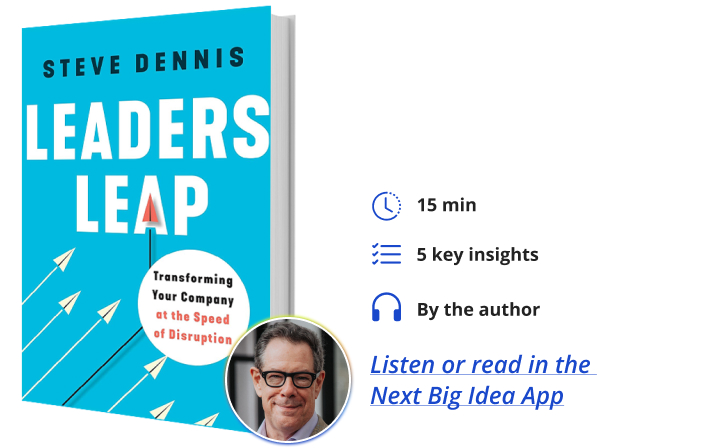Steve Dennis is a strategy and innovation consultant, keynote speaker, podcast host, and bestselling author. He has been named a top global retail influencer by multiple organizations, and his thoughts on the future of shopping are regularly shared in his role as a Forbes Senior Contributor, as well as through other media, including CNN, The Wall Street Journal, and Bloomberg. Steve is the President of SageBerry Consulting and a former SVP at the Neiman Marcus Group. Steve holds an MBA from the Harvard Business School and a BA in Economics from Tufts University.
Below, Steve shares five key insights from his new book, Leaders Leap: Transforming Your Company at the Speed of Disruption. Listen to the audio version—read by Steve himself—in the Next Big Idea App.

1. Shift happens. And it’s happening faster all the time.
It’s hard to overstate the seismic shifts that have upended most sectors of the economy during the past two decades. E-commerce has created a 24/7 world of abundant choice and nearly frictionless shopping while allowing powerful new competitors like Amazon, Alibaba, and many more to emerge and gobble up market share. At the same time, they are bringing iconic, once-dominant retailers to their knees.
Ever more powerful and connected digital technology has fueled the massive growth of search engines and social media platforms. The advent of smart devices has unleashed connections between individuals and brands in ways that once seemed unimaginable. The ability of technology to power “sharing economy” models like Uber and Airbnb has completely reshaped the competitive landscape.
A highly concentrated media ecosystem has given way to a landscape either dominated by newer players like Netflix and TikTok or the long tail of micro-influencers. Game-changing technology like generative AI can often seem to come out of nowhere to reset the playing field again.
As change now happens more exponentially, rather than in a linear fashion, failure to respond quickly and boldly can make it depressingly easy for an insurmountable gap to be created between what the market demands and what we can deliver.
2. Beware the Innovator’s New Dilemma.
Harvard Business School Professor Clayton Christensen first pointed out the Innovator’s Dilemma in his groundbreaking 1997 book. Christensen observed that large, historically successful incumbent organizations often fail to respond to disruptive new technology because they default to defending their core business. This relentless protection of the status quo makes them vulnerable to increasing irrelevance over time.
While much of what Christensen observed remains true, much has changed since his work began to have its impact. Today, everything that can be connected is connected. Ideas and business models that used to take years to reach critical mass can now spread in months or weeks. The reliance on physical assets as a competitive advantage continues to dwindle.
“This relentless protection of the status quo makes them vulnerable to increasing irrelevance over time.”
Because change unfolds far more quickly, so must our response. The Innovator’s New Dilemma is that our failure to aim higher, move faster, and act more boldly can put our organization at risk in ways that were not previously possible.
3. I’m the problem. It’s me.
Steven Pressfield once stated, “There is an enemy. That enemy is you.” In my view, too many books on strategy and leadership default to talking about companies in broad, often abstract terms. To be sure, culture is important, and organizations are complex and difficult to change. But in my direct experience on the senior leadership teams of two Fortune 500 retailers, in working with dozens of organizations on their growth strategies, and in studying the winners and losers of the past two decades, the starting place of any transformation must start with a fearless personal inventory. We have to hold up a mirror to ourselves. Such a rigorous examination often reveals that our egos are our worst enemies.
Transformation requires courageous leadership. And courageous leadership requires vulnerability. It calls us to skate to the perimeters of our ignorance, to ask for help, and to admit that we alone cannot fix this. It often demands that we rethink many of the beliefs we’ve held, that we untangle our confirmation biases, and that we let go of the skills that have enabled our success to embrace a new paradigm for leadership. Indeed, we got us here, so it is not likely to get us to where we need to go.
4. Safe is risky.
In the process of embracing this vulnerability, I advocate for seven leadership mind leaps. That involves adopting entirely new paradigms to help us leap toward a better future for ourselves and our organizations.
Perhaps the hardest one to embrace, at least from the evidence of the last several years, is the notion that “safe is risky.”
Once iconic companies are now gone, or mere shells of themselves because they failed to transform in the face of disruption. Bed, Bath & Beyond, Blackberry, Blockbuster, and Borders all watched the last twenty years happen to them. They chose to engage in timid transformation when they needed a radical re-conception of their business models.
Time and time again, we see companies default to a “faster horse” strategy when what they need is something very different. While many of us say we want to change, mostly what we want to do is the same things but just a little bit better. Often, it is fear that keeps us stuck in old ways of doing things or, at best, engaging in what some have called “infinite incrementalism.”
“We must quantify the cost of our inaction.”
Fear of failure is real, and it is pernicious. But fear is the dragon we must slay. We must redefine our relationship to risk. We must quantify the cost of our inaction; we must accept that the price of irrelevance may very well be extinction.
Mark Zuckerberg, Meta’s CEO, states it well: “In a world that’s changing really quickly, the only strategy that is guaranteed to fail is not taking risks.” Said differently, fortune favors the bold.
5. Embrace the fierce urgency of now.
In his book Journey to Ixtlan, Carlos Castaneda writes, “The problem is you think you have time.” What’s happened since the turn of the century, and what’s only accelerated dramatically during the past several years, is revolutionary. Yet, too many organizations have largely been sleepwalking through the revolution.
Take the department store industry, which has been dramatically declining for two decades. Macy’s, JC Penney, Sears, et al. have engaged in round after round of cost-cutting and store closings. They have acted as if they’ve had all the time in the world to address their core issues of failing to be truly relevant and highly differentiated. This will end badly.
The fact is we see organizations in all sectors, companies big and small, for-profit and not, choose to ride the brake when they need to step on the gas. To end with a famous Chinese proverb: “The best time to plant a tree was twenty years ago. The second-best time is now.”
To listen to the audio version read by author Steve Dennis, download the Next Big Idea App today:































